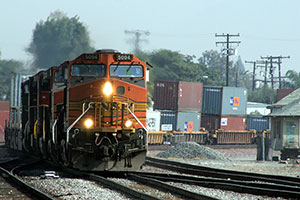California Court Ruling Blocks $500 Million Rail Project

BNSF Railway’s plan to build a $500 million intermodal terminal near the docks in Los Angeles and Long Beach, California has suffered a setback that could endanger to project from a California court ruling that the state’s environmental rules were violated.
Superior Court Judge Barry Goode, in a 200-page ruling, found that the project known as the Southern California International Gateway, or SCIG, that the largest U.S. truck/rail carrier has been pursuing for more than 10 years didn’t receive enough analysis and mitigation when Los Angeles officials approved it three years ago.
Specifically, Goode threw out the environmental analysis done by the Los Angeles port agency and said the project couldn’t proceed until that city does a more thorough analysis. The court ruling noted that the project has generated 200,000 pages of documents relating to it.
The Fort Worth, Texas-based railway’s project is intended to reduce truck trips of international cargo by rerouting trucks that now make a 24-mile, one-way trek to a location less than five miles from the port. It was opposed by neighborhood organizations in Long Beach that would be adjacent to the proposed facility, and by the City of Long Beach. The two cities are home to the largest U.S. ports, processing more than 10 million shipments annually, including 1.3 million or more truck trips each year that could be made to and from the SCIG.
“While BNSF is still carefully reviewing the lengthy ruling, upon initial review, we are disappointd because the decision appears to delay a nationally and regionally significant transportation infrastructure project,” the railroad said in a statement. "BNSF will coordinate with the Port of Los Angeles to determine our next steps.”
Saying it was a “body blow” for the region’s economy, Los Angeles port officials also criticized the court ruling, saying the railroad “stands ready to invest more than $500 million in private funds to develop a facility that will greatly improve air quality for those nearby and throughout the region, create thousands of construction and permanent jobs, reduce traffic in local neighborhoods and on the 710 Freeway, and support the national and global competitiveness of both ports. On the whole, SCIG would have dramatically reduced congestion and emissions."
On the other side, Long Beach City Attorney Charles Parkin said, “We are relieved the court heard and understood our concerns about the impacts of the SCIG project, which would significantly increase air pollution in an area where residents already face too many health hazards.”
The impacts cited by opponents were the increased amount of trucks in a residential neighborhood, where air quality, noise and traffic were not adequately considered. Among the issues that weren’t fully considered were traffic on San Gabriel Avenue, noise levels calculated on an average instead of maximum basis and the impact of the project on the existing BNSF terminal.
BNSF proposed the project as an alternative to trucking cargo between the ports and the existing intermodal terminal known as Hobart. The truck haul to the 185-acre SCIG would be fewer than 4 miles. The Hobart facility is across the street from a Union Pacific Railroad intermodal terminal. UP also has an intermodal terminal fewer than 5 miles from the docks that has been operating for about two decades.
Long Beach officials praised the ruling, saying that city was working on projects that would “buffer residents from the impacts of goods movement” by “investing in projects to move cargo in a more efficient, environmentally sustainable way.”
Los Angeles and Long Beach have on-dock rail facilities within port terminals that carry a portion of international cargo to and from the region without any highway trips, using a rail route known as the Alameda Corridor.




